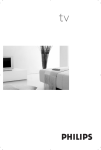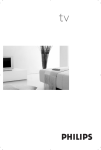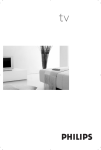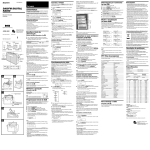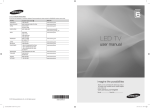Download Philips DSI260 User's Manual
Transcript
tv Introduction Thank you for purchasing this television set. This handbook has been designed to help you install and operate your TV set. We would strongly recommend that you read it thoroughly. Table of Contents Installation Installing your television set . . . . . . . . . . . . . . . . . . . . . . . . . . . . . . . . . . . . . . . . . .2 The keys on the TV set . . . . . . . . . . . . . . . . . . . . . . . . . . . . . . . . . . . . . . . . . . . . . .2 Remote control keys . . . . . . . . . . . . . . . . . . . . . . . . . . . . . . . . . . . . . . . . . . . . . . .3 Quick installation . . . . . . . . . . . . . . . . . . . . . . . . . . . . . . . . . . . . . . . . . . . . . . . . . .4 Program sort . . . . . . . . . . . . . . . . . . . . . . . . . . . . . . . . . . . . . . . . . . . . . . . . . . . . . .4 Program name . . . . . . . . . . . . . . . . . . . . . . . . . . . . . . . . . . . . . . . . . . . . . . . . . . . . .4 Manual store . . . . . . . . . . . . . . . . . . . . . . . . . . . . . . . . . . . . . . . . . . . . . . . . . . . . . .5 Favourite Programmes . . . . . . . . . . . . . . . . . . . . . . . . . . . . . . . . . . . . . . . . . . . . . .5 Other settings in the Install menu . . . . . . . . . . . . . . . . . . . . . . . . . . . . . . . . . . . . .5 Operation Picture settings . . . . . . . . . . . . . . . . . . . . . . . . . . . . . . . . . . . . . . . . . . . . . . . . . . . .6 Sound adjustments . . . . . . . . . . . . . . . . . . . . . . . . . . . . . . . . . . . . . . . . . . . . . . . . .6 Feature settings . . . . . . . . . . . . . . . . . . . . . . . . . . . . . . . . . . . . . . . . . . . . . . . . . . . .6 Timer function . . . . . . . . . . . . . . . . . . . . . . . . . . . . . . . . . . . . . . . . . . . . . . . . . . . .7 TV lock . . . . . . . . . . . . . . . . . . . . . . . . . . . . . . . . . . . . . . . . . . . . . . . . . . . . . . . . . .7 Teletext . . . . . . . . . . . . . . . . . . . . . . . . . . . . . . . . . . . . . . . . . . . . . . . . . . . . . . . . . .8 16:9 Formats . . . . . . . . . . . . . . . . . . . . . . . . . . . . . . . . . . . . . . . . . . . . . . . . . . . . . .9 Using PIP . . . . . . . . . . . . . . . . . . . . . . . . . . . . . . . . . . . . . . . . . . . . . . . . . . . . . . . . .9 Peripherals Video recorder . . . . . . . . . . . . . . . . . . . . . . . . . . . . . . . . . . . . . . . . . . . . . . . . . . .10 Other equipment . . . . . . . . . . . . . . . . . . . . . . . . . . . . . . . . . . . . . . . . . . . . . . . . .10 To select connected equipment . . . . . . . . . . . . . . . . . . . . . . . . . . . . . . . . . . . . .10 Sides connections . . . . . . . . . . . . . . . . . . . . . . . . . . . . . . . . . . . . . . . . . . . . . . . . .11 Video recorder or DVD keys . . . . . . . . . . . . . . . . . . . . . . . . . . . . . . . . . . . . . . . .11 Practical information Tips . . . . . . . . . . . . . . . . . . . . . . . . . . . . . . . . . . . . . . . . . . . . . . . . . . . . . . . . . . . .12 Glossary . . . . . . . . . . . . . . . . . . . . . . . . . . . . . . . . . . . . . . . . . . . . . . . . . . . . . . . .12 ° Recycling The materials used in your set are either reusable or can be recycled. To minimise environmental waste, specialist companies collect used appliances and dismantle them after retrieving any materials that can be used again (ask your dealer for further details). 1 Installing your television set & Positioning the television set “ Remote control 5 cm 5 cm 5 cm Place your TV on a solid, stable surface, leaving a space of at least 5 cm around the appliance. To avoid accidents, do not put anything on the set such as a cloth or cover, a container full of liquid (vase) or a heat source (lamp). The set must not be exposed to water. é Connections Insert the two R6-type batteries (supplied) making sure that they are the right way round. Check that the mode selector is set to TV. The batteries supplied with this appliance do not contain mercury or nickel cadmium. If you have access to a recycling facility, please do not discard your used batteries (if in doubt, consult your dealer).When the batteries are replaced, use the same type. ‘ Switching on • Insert the aerial plug into the : socket at the rear of the set. If you are using an indoor aerial, reception may be difficult in certain conditions.You can improve reception by rotating the aerial. If the reception remains poor, you will need to use an external aerial. • Insert the mains plug into a wall socket (220-240 V / 50 Hz). To switch on the set, press the on/off key. A red indicator comes on and the screen lights up. Go straight to the chapter Quick installation on page 4. If the television remains in standby mode, press P # on the remote control. The indicator will flash when you use the remote control. The keys on the TV set The television set has 4 or 5 keys which are located on the front or the top of the set depending on the model. The VOLUME - + (- ” +) keys are used to 2 adjust sound levels.The PROGRAM - + (- P +) keys are used to select the required programmes. To access the menus, simultaneously hold down the ” - and ” + keys (or MENU key). The PROGRAM - + keys may then be used to select an adjustment and the - ” + keys to make that adjustment. To exit from the menus, hold down the 2 ” and ” + keys (or MENU key). Note : when the Child Lock function is activated, these keys are unavailable (refer to Features menu on page 7). Remote control keys Standby To set the TV to standby mode. To switch the TV set on again, press b, P @ # or 0 9. Surround Sound To activate / deactivate the surround sound effect. In stereo, this gives the impression that the speakers are further apart. For models equipped with Virtual Dolby Surround*, you can experience Dolby Surround Pro Logic sound effects. Select peripherals (p.10) Press several times to select the required EXT connector. NEXTVIEW: refer to the separate booklet (only available on certain models). VCR DVD SAT AMP CD Ÿ Y · ¢ List of programmes To display/clear the list of programmes. Use the <> cursor to select a programme and the ≥ cursor to display it. The symbol + is displayed alongside all programmes which are locked (p.7). † Select ¢ Ê Æ œ π ‡ unused key. Menu To call up or exit the menus. OK Freeze the picture MENU Mute To mute or restore the sound. Screen information To display / remove the programme number, the name (if it exists), the time, the sound mode and the time remaining on the timer. Hold down for 5 seconds to permanently display the programme number on the screen.The volume level and the smart control adjustments are then displayed each time they are used. ” [ P 1 2 3 4 5 6 7 8 9 Ë 0 ù Active Control (according to the version) Optimizes the quality of the picture according to the quality of reception. ACTIVE ` SMART Dual screen (according to the version) To activate/disable the display on 2 screens. The second screen displays teletext. Teletext keys (p. 8) or VCR / DVD (p.11). Teletext (p. 8). Œ Cursor These 4 keys are used to move around the menus (<>≤≥). Volume To adjust the sound level. Mode selector (p. 11) To activate the remote control in TV, VCR, DVD, SAT,AMP or CD mode. - CONTROL K SMART Programme selection To access the next or previous TV channel from the list of Favourite Programmes (see p. 5). Digit keys Direct access to the programmes. For a 2 digit programme, enter the 2nd digit before the dash disappears. Sound mode Used to force programmes in Stereo and Nicam Stereo to Mono or, for bilingual programmes, to choose between Dual I or Dual II. The Mono indication is red when in forced position. Sleeptimer To select the length of time before the set automatically switches to standby (from 0 to 240 minutes). ª 16:9 Format (p. 9). Smart picture and sound Used to access a series of predefined picture and sound settings. The personal position relates to settings selected from the menus. * Manufactured under license from Dolby Laboratories. “Dolby” and the double-D symbols are trademarks of Dolby Laboratories. 3 Quick installation The first time you switch on the television, a menu appears on the screen and the tuning starts automatically. Main • Install • Searching Please Wait Prog. found 3 525,25 MHz Auto Store • If the menu is not displayed, press and hold down the ”- and ”+ keys on the TV set for 5 seconds to start the tuning. All the available TV programs will be stored. This operation takes a few minutes.The display shows the progress of the search and the number of programs found. At the end of the search, the menu disappears. To exit or interrupt the search, press H. If no program is found, consult the possible solutions p. 12. & If the transmitter or cable network sends the automatic sort signal, the programs will be numbered correctly. In this case, the installation is complete. é If this is not the case, you need to use the Sort menu to number the programs correctly. Some transmitters or cable networks broadcast their own sort parameters (region, language, etc.). In this case, indicate your choice using the <> keys and validate with ≥. Program sort & Press key H.The Main menu is displayed on the screen. Main • Install • Language Country Auto Store Manuel Store Sort Program Name • • • • • • • 00 01 BBC1 02 BBC2 03 Æ ANGLI 04 CH4 05 CH5 é With the cursor, select the Install menu followed by the Sort menu. “ Select the programme you want to move using the <> cursor and press ≥. ‘ Then use the <> cursor to select the new number and validate with ≤. ( Repeat steps “ and ‘ for each program you wish to renumber. § To quit the menus, press d. Program name If required, you can give a name to the programmes and external connectors. Note : on installation, the programs are named automatically when an identification signal is sent. & Press the H key. é With the cursor, select the Install menu, then Name. “ Use the @ P # keys to select the programme to name or rename. 4 ‘ Use the ≤≥ cursor to move around the name display area (5 characters) and the <> cursor to select the characters. ( When the name has been entered, use the H cursor to exit.The name is stored. § Repeat steps “ to ( for each programme you wish to name. è To quit the menus, press d. Manual store This menu is used to store the programmes one at a time. & Press the H key. é With the cursor, select the Install menu then Manual store : Main • Install • Language Country Auto Store Manuel Store Sort Program Name • • • System Search Program No. Fine Tune Store • • • • • • • • “ System: select Europe (automatic detection*) or Western Europe (BG standard), Eastern Europe (DK standard), United Kingdom (I standard) or France (LL’ standard). * Except for France (LL’ standard), you must select choice France. ‘ Search : press ≥.The search starts. Once a programme is found, the scanning stops and its name is displayed (when available). Go to the next step. If you know the frequency of the required programme, this can be entered directly using the 0 to 9 keys. If no picture is found, consult the possible solutions (p. 12). ( Program No. : enter the required number with the ≤≥ or 0 to 9 keys. Example : program 1, enter 01. § Fine Tune : if the reception is not satisfactory, adjust using the ≤≥ cursor. è Store : press ≥.The program is stored. ! Repeat steps ‘ to è for each programme to store. ç To quit the menus, press d. Favourite programmes This menu allows you to select the programmes to be accessed with the @ P # key. & Press the H key. é With the cursor, select the Install menu then Favourite Progr. and press ≥. Main • Install • Language Country Auto Store Manuel Store Sort Favourite Progr. Name “ ‘ • • • • • ( 2• • § The list of favourite programmes is displayed. The programmes that were stored at installation will automatically appear on this list. Use the up/down cursor to select the required programme. Use the left/right cursor to add or remove a programme from the list. Run through steps “ and ‘ for each programme to be added or removed from the list. To exit, press d several times. Other settings in the Install menu & Press the H key and select the Install menu: é Language : to change the display language for the menus. “ Country : to select your country (GB for Great Britain). This setting is used for the search, automatic programme sort and teletext display. If your country does not appear in the list, select “. . .” ‘ Auto Store : to start automatic search for all programmes available in your region. If the transmitter or cable network sends the automatic sort signal, the programmes will be numbered correctly. If this is not the case, you need to use the Sort menu to renumber the programmes (see p. 4). Some transmitters or cable networks broadcast their own sort parameters (region, language, etc.). In this case, indicate your choice using the <> cursor and validate with ≥.To quit or interrupt the search, press H. If no picture is found, consult the possible solutions (p. 12). ( To quit the menus, press d. 5 Picture settings & Press H then ≥ cursor.The Picture menu is displayed : Main • Picture Sound • Features • Install • Brightness Colour Contrast Sharpness Colour Temp. Digital Options Store • • • • • • • é Use the <> cursor to select a setting and the ≤≥ cursor to adjust. Note : during the picture adjustment, only the selected line remains displayed. Press <> to display the menu again. Description of the adjustments : • Brightness : this changes picture brilliance. • Colour : this changes the intensity of the colour. • Contrast : this changes the difference between the light and dark tones. • Sharpness : this changes the picture definition. • Colour Temp.: this changes the colour rendering: Cold (bluer), Normal (balanced) or Warm (redder). • Digital Options : - 100 Hz : 100 Hz processing. - Digital Scan (according to the version) : reduces line flicker which is visible on some pictures. - Double lines : doubling of vertical resolution which removes visible picture lines. Advised for NTSC (60Hz) pictures. “ Once the adjustments have been made, select Store and press ≥ to store them. Press d to exit. Sound adjustments & Press H, select Sound (>) and press ≥.The Sound menu is displayed : Main • Picture • Sound Features • Install • Treble Bass Balance Delta Volume AVL HP Volume Store • • • • • • • é Use the <> cursor to select a setting and the ≤≥ cursor to adjust. Description of the settings : • Treble : this alters the high frequency sounds. • Bass : this alters the low frequency sounds. • Balance : this balances the sound on the left and right speakers. • Delta Volume : this is used to compensate any volume discrepancies between the different programs or EXT sockets. This setting is available for programs 0 to 40 and the EXT sockets. • AVL (Automatic Volume Leveller) : this is used to limit increases in sound, especially on program change or advertising slots. • HP Volume : allows you to adjust the headphones volume independently from the loud-speakers on the TV set. “ Once the adjustments have been made, select Store and press ≥ to store these changes. ‘ To quit the menus, press d. Feature settings & Press H, select Features (>) and press ≥.You can adjust : é Timer, Child Lock and Parental Cont. : see next page “ DNR: Min, Med (optimum position), Max or Off : attenuates picture noise (snow) in difficult reception conditions. ‘ Rotation (only available on very large screen sets) : large screen sets are sensitive to terrestrial magnetic field variations. This setting is used to compensate for this by 6 adjusting the picture rotation. ( Dynamic Contrast (according to the version) : Min, Med (optimum position), Max or Off. Enhances the contrast of details in lighter, average and darker areas. § Decoder : select the programme(s) that use the external decoder then select the connector where the decoder is connected : EXT1 or EXT2. If the decoder is connected to the video recorder, select the video recorder’s connector (EXT2). è To quit the menus, press d. Timer function This menu lets you use the TV set as an alarm. & Press the H key. é With the cursor, select the Features menu then Timer : Main • Picture • Sound • Features Install • Timer Child Lock Parental control DNR Rotation Dynamic Contrast Decoder • • • • • • • Time Start Time Stop Time Program No. Activate “ Time : enter the current time. Note : the time is updated automatically each time the TV set is switched on via the teletext information on programme 1. If this program does not have teletext, the update will not take place. ‘ Start Time : enter the start time. ( Stop Time : enter the standby time. § Program No. : enter the number of the programme for the wake-up alarm. è Activate : the settings include: • Once for a single alarm, • Daily for each day, • Stop to cancel. ! Press b to put the TV set in standby. It will automatically come on at the time programmed. If you leave the TV set on, it will just change programmes at the time entered (and will go to standby mode at the Stop Time). By combining the TV lock and Timer functions, you can restrict the period during which the TV set is used, for example by your children. TV lock You can block certain programs or inhibit use of the TV set completely by locking the keys. “ Child lock & Press H. é With the cursor, select the Features menu and position Child Lock to On. Main • Picture • Sound • Features Install • Timer Child Lock Parental control DNR Rotation Dynamic Contrast Decoder • • • • • • • On • Off • ‘ “ Turn off the TV set and hide the remote control.The TV set cannot be used (except via the remote control). ‘ To cancel : position Child Lock to Off. ( Parental control § & Press the H key, select the Features menu then Parental Cont. : é You must enter your secret access code. The first time you enter this, enter code 0711 è twice and then enter your new code choice. The menu is displayed. Parental Cont. : Use the <> cursor to select the TV programme required and validate with ≥.The + symbol will be displayed opposite the programmes or sockets that are locked. From now on, to view a locked programme, you must enter your secret code, otherwise the screen will stay blank. The access to the Install menu is also locked. Caution, for encrypted programs using an external decoder, you must lock the corresponding EXT socket. Change code : this allows you to enter a new 4 digit code. Confirm your new code by entering it a second time. If you have forgotten your secret code, enter the universal code 0711 twice. Unlock all : this is used to unlock all locked programmes. Lock All : this is used to lock all the TV programmes and EXT connectors. Press the d key to quit. 7 Teletext Teletext is an information system broadcast by certain channels which can be consulted like a newspaper. It also offers access to subtitles for viewers with hearing problems or who are not familiar with the transmission language (cable networks, satellite channels, etc.). Press : You will obtain : Teletext call ¤ POWER . VCR DVD SAT AMP CD Ÿ ¢ Y Select · ¢ Ê Æ ¤ œ π ‡ Œ 0 9 - OK P + Selecting a page Enter the number of the page required using the 0 to 9 or @ P # keys. Example: page 120, enter 1 2 0.The number is displayed top left, the counter turns and then the page is displayed. Repeat this operation to view another page. If the counter continues to search, this means that the page is not transmitted. Select another number. Direct access to the items Coloured areas are displayed at the bottom of the screen. The 4 coloured keys are used to access the items or corresponding pages. The coloured areas flash when the item or the page is not yet available. MENU + ” + [ P 1 2 3 4 5 6 7 8 9 Ë 0 ù Ë This is used to call teletext, change to transparent mode and then exit.The summary appears with a list of items that can be accessed. Each item has a corresponding 3 digit page number. If the channel selected does not broadcast teletext, the indication 100 will be displayed and the screen will remain blank (in this case, exit teletext and select another channel). Contents This returns you to the contents page (usually page 100). ACTIVE ` SMART - CONTROL SMART OK ª OK ù Ÿ Y MENU Ë 8 Direct selection of sub-pages Certain pages contain sub-pages (for example, page 120 contains sub-pages 1/3, 2/3 and 3/3). Use the ≤≥ cursor to directly access the sub-pages of your choice. Enlarge a page This allows you to display the top or bottom part of the page and then return to normal size. Double page teletext (only available on certain versions) To activate or deactivate the double page teletext display mode.The active page is displayed on the left and the following page is displayed on the right. Press i if you want to hold a page (i.e. the contents page).The active page is then displayed on the right.To return to normal mode, press e. Hidden information To display or hide the concealed information (games solutions). Favourite pages Instead of the standard coloured areas displayed at the bottom of the screen, you can store 4 favourite pages on the first 40 channels which can then be accessed using the coloured keys (red, green, yellow, blue). Once set, these favourite pages will become the default every time tetetext is selected. & Press the H key to change to favourite pages mode. é Display the teletext page that you want to store. “ Press the coloured key of your choice for 3 seconds. The page is now stored. ‘ Repeat the operation with the other coloured keys. ( Now when you consult teletext, your favourite pages will appear in colour at the bottom of the screen. To temporaly retrieve the standard items, press H. To clear everything, and return the standard items as the default, press d for 5 seconds. 16:9 Formats The pictures you receive may be transmitted in 16:9 format (wide screen) or 4:3 format (conventional screen). 4:3 pictures sometimes have a black band at the top and bottom of the screen (letterbox format).This function allows you to optimise the picture display on screen. If your television is equipped with a 4:3 screen. Press the p key (or <> cursor) to select the different modes: 4:3 Expand 4:3 Compress 16:9 The picture is reproduced in 4:3 format. The picture is enlarged vertically.This mode is used to cancell the black bands when watching a programme in letterbox format. The picture is compressed vertically into 16:9 format. If your television is equipped with a 16:9 screen. Press the p key (or ≤≥ cursor) to select the different modes: This TV set is also equipped with automatic switching which will select the correct-screen format, provided the specific signals are transmitted with the programmes. 4:3 The picture is reproduced in 4:3 format and a black band is displayed on either side of the picture.The picture may be progressively enlarged using the <> cursor. Zoom 14:9 The picture is enlarged to 14:9 format, a thin black band remains on both sides of the picture.The <> cursor allow you to compress and move the image vertically to view the top or bottom of the picture (subtitles). Zoom 16:9 The picture is enlarged to 16:9 format.This mode is recommended when displaying pictures which have black bands at the top and bottom (letterbox format). Use the <> cursor if you wish to compress and move the image vertically to view the top or bottom of the picture. Subtitle Zoom This mode is used to display 4:3 pictures using the full surface of the screen leaving the sub-titles visible. Use the <> cursor to increase or decrease the compression at the bottom of the screen. Super Wide This mode is used to display 4:3 pictures using the full surface of the screen by enlarging the sides of the picture.The <> cursor allow you to scroll the image up or down the screen. Widescreen This mode restores the correct proportions of pictures transmitted in 16:9 using full screen display. Auto Format Using PIP (only available on certain versions). The format of the picture is automatically adjusted to fill as much of the screen as possible. (only available on certain versions) This feature enables you to display a small superimposed window.You can display in this window the picture from an appliance connected to the TV (e.g. video recorder,DVD, ...). & Press the œ key to display the PIP screen. A small superimposed window appears in the main screen. é Use the µ key to select a picture from the appliance connected to the TV. “ Press the œ key again to change the size of the window then make it disappear. ‘ Use the π key if you want to hide the window.You can also shift it progressively by using the cursor (only on position 5). ( Use the ‡ key if you want to swap the 2 pictures. 9 Connecting peripheral equipment Depending on the versions, the TV set is equipped with 2 or 3 SCART connectors EXT1, EXT2 and EXT4 located on the rear. The EXT1 connector has audio video inputs/outputs and RGB inputs. The EXT2 connector has audio video inputs/outputs and S-VHS inputs. The EXT4 connector (if available) has audio video inputs/outputs and RGB inputs. Video recorder CABLE EXT 2 VCR Other equipment CABLE Carry out the connections shown opposite, using a good quality euroconnector cable. If your video recorder does not have a euroconnector socket, the only connection possible is via the aerial cable.You will therefore need to tune in your video recorder's test signal and assign it programme number 0 (refer to manual store, p. 5). To reproduce the video recorder picture, press 0. Video recorder with decoder Connect the decoder to the second euroconnector socket of the video recorder.You will then be able to record scrambled transmissions. See also the Decoder menu (page 6). Satellite receiver, decoder, DVD, games, etc. Carry out the connections shown opposite. To optimise picture quality, connect the equipment which produces the RGB signals (digital decoder, games, etc.) to EXT1 or EXT4, and the equipment which produces the S-VHS signals (SVHS and Hi-8 video recorders, certain DVD drives) to EXT2. To select connected equipment Press the µ key to select EXT1, EXT2, S-VHS2 (S-VHS signals from the EXT2 socket), EXT3 for connections on the front panel and EXT4 (if available). Most equipment (decoder, video recorder) carries out the switching itself. Side connections EO S•VID O VIDE AUD Make the connections as shown opposite. With the µ key, select EXT3. For a mono set, connect the sound signal to the AUDIO L (or AUDIO R) input.The sound automatically comes out of the left and right speakers of the set. IO * Headphones Press the m key to mute the sound on the TV set (see also sound settings, page 6). The headphone impedance must be between 32 and 600 Ohms. Amplifier (only available on certain versions) To connect to a hi-fi system, use an audio connection cable and connect the “L” and “R” outputs on the TV set to the “AUDIO IN” “L” and “R” input on your hi-fi amplifier. AUDIO 10 EasyLink Function (only available on certain versions) If your video recorder has an EasyLink function, during installation, the language, country and available channels are automatically transmitted to the video recorder. Equally, when the video recorder is in standby, pressing the · key on the remote control will start the recording of the same programme displayed on the TV set. The video recorder must be connected to the EXT2 connector (see p. 10). Video recorder or DVD, SAT,AMP, CD keys The remote control lets you control the main functions of the VCR or DVD. POWER . VCR DVD SAT AMP CD Ÿ ¢ Y Select · ¢ Ê Æ ¤ œ π ‡ Œ OK MENU + + ” [ P 1 2 3 4 5 6 7 8 9 Ë 0 ù ACTIVE ` SMART - CONTROL SMART ª Press the Select key to select the required mode : VCR, DVD, SAT, AMP or CD.The remote control indicator lights up to display the selected mode. It switches off automatically after 60 seconds if left idle. The remote control automatically returns to TV mode. The following keys are operational, depending on the equipment : . ¢ ∫ · Ê Æ i c o standby, fast rewind, fast forward, recording, stop, play, pause, DVD : subtitling language DVD : subtitle selection VCR : tape list function, H menu, cursor navigation and adjustments, u validation, 09 digit keys, @ P # programme selection, e audio selection. d OSD menu, % VCR timer. The remote control is compatible with all video recorders using the RC5 standard and all DVDs using the RC6 standard. 11 Tips Poor reception The proximity of mountains or high buildings may be responsible for ghost pictures, echoing or shadows. In this case, try manually adjusting your picture: see Fine Tuning (p.5) or modify the orientation of the outside aerial. Does your antenna enable you to receive broadcasts in this frequency range (UHF or VHF band)? In the event of difficult reception (snowy picture) switch the Dynamic NR on the Features menu to ON. (p. 6). No picture If the television does not switch on, please press the standby key b (located on the remote control) twice. Have you connected the aerial socket properly? Have you chosen the right system? (p. 5). Poorly connected euroconnector cables or aerial sockets are often the cause of picture or sound problems (sometimes the connectors can become half disconnected if the TV set is moved or turned). Check all connections. Peripheral equipment gives a black and white picture To play a video cassette, check that it has been recorded under the same standard (PAL, SECAM, NTSC) which can be replayed by the video recorder. The remote control no longer works Check that the mode selector on the side of the remote control is set to TV. No sound If on certain channels you receive a picture but no sound, this means that you do not have the correct TV system. Modify the System setting (p. 5). Teletext Are certain characters not displayed correctly? Check that the Country setting has been positioned correctly (p.5). Remote control The TV set does not react to the remote control; the indicator on the set no longer flashes when you use the remote control? Replace the batteries. Standby When you switch the TV set on it remains in standby mode and the indication Locked is displayed when you use the keys on the TV set? The Child Lock function is switched On (p. 7). If the set receives no signal for 15 mins, it automatically goes into standby mode. To save power, your set is fitted with components that give it a very low power consumption when in standby mode (less than 1 W). Still no results ? If your TV set breaks down, never attempt to repair it yourself: contact your dealer's aftersales service. Cleaning the set Only use a clean, soft and lint-free cloth to clean the screen and the casing of your set. Do not use alcohol-based or solvent-based products. Glossary RGB Signals : These are 3 Red, Green and Blue video signals which directly drive the red, green and blue emitters in the cathode ray tube. Using these signals provides better picture quality. NICAM sound : Process by which digital sound can be transmitted. System : Television pictures are not broadcast in the same way in all countries.There are different standards: BG, DK, I, and L L’.The SYSTEM setting (p. 6) is used to select these different standards. This is not to be confused with PAL or SECAM colour coding. Pal is used in most countries in Europe, Secam in France, Russia and most African countries.The United States and Japan use a different system called NTSC. 100Hz : Conventional televisions (50 Hz) produce a visible image flicker.Thanks to 100 Hz technology, the scanning frequency is doubled. It is visually more comfortable and the flickering effect is reduced. 16:9 : Refers to the ration between the length and height of the screen. Wide screen televisions have a ration of 16/9, conventional screen TV sets have a ration of 4/3. 12 Table of TV frequencies. Frequenztabelle der Fernsehsender. Liste des fréquences TV. Frequentietabel TV-Zenders. Tabella delle frequenze TV. Lista de frecuencias TV. Lista das frequências TV Liste over TV senderne. Tabell over TV-frekvenser. Tabell över TV-frekvenser. TV-taajuustaulukko. K·Ù¿ÏÔÁÔ˜ Û˘¯ÓÔÙ‹ÙˆÓ ÔÌÒÓ. CÔËÒÓÍ ˜‡ÒÚÓÚ Ô‰‡Ú˜ËÍÓ‚. A televizió-adóállomások frekvenciáinak a listája. Lista częstotliwości stacji nadawczych. Seznam frekvenčních pásem vysílačů. Zoznam frekvenčných pásiem vysielačov. FRANCE EUROPE CANAL ................FREQ (MHz) E2 ........................48.25 E3 ........................55.25 E4 ........................62.25 E5 ......................175.25 E6 ......................182.25 E7 ......................189.25 E8 ......................196.25 E9 ......................203.25 E10 ....................210.25 E11 ....................217.25 E12 ....................224.25 R1 ........................49.75 R2 ........................59.25 R3 ........................77.25 R4 ........................85.25 R5 ........................93.25 R6 ......................175.25 R7 ......................183.25 R8 ......................191.25 R9 ......................199.25 R10 ....................207.25 R11 ....................215.25 R12 ....................223.25 S1 ......................105.25 S2 ......................112.25 S3 ......................119.25 S4 ......................126.25 S5 ......................133.25 S6 ......................140.25 S7 ......................147.25 S8 ......................154.25 S9 ......................161.25 S10 ....................168.25 S11 ....................231.25 S12 ....................238.25 S13 ....................245.25 S14 ....................252.25 CANAL ................FREQ (MHz) S15 ....................259.25 S16 ....................266.25 S17 ....................273.25 S18 ....................280.25 S19 ....................287.25 S20 ....................294.25 H1 ......................303.25 H2 ......................311.25 H3 ......................319.25 H4 ......................327.25 H5 ......................335.25 H6 ......................343.25 H7 ......................351.25 H8 ......................359.25 H9 ......................367.25 H10 ....................375.25 H11 ....................383.25 H12 ....................391.25 H13 ....................399.25 H14 ....................407.25 H15 ....................415.25 H16 ....................423.25 H17 ....................431.25 H18 ....................439.25 H19 ....................447.25 21.......................471.25 22.......................479.25 23.......................487.25 24.......................495.25 25.......................503.25 26.......................511.25 27.......................519.25 28.......................527.25 29.......................535.25 30.......................543.25 31.......................551.25 32.......................559.25 CANAL ................FREQ (MHz) 33.......................567.25 34.......................575.25 35.......................583.25 36.......................591.25 37.......................599.25 38.......................607.25 39.......................615.25 40.......................623.25 41.......................631.25 42.......................639.25 43.......................647.25 44.......................655.25 45.......................663.25 46.......................671.25 47.......................679.25 48.......................687.25 49.......................695.25 50.......................703.25 51.......................711.25 52.......................719.25 53.......................727.25 54.......................735.25 55.......................743.25 56.......................751.25 57.......................759.25 58.......................767.25 59.......................775.25 60.......................783.25 61.......................791.25 62.......................799.25 63.......................807.25 64.......................815.25 65.......................823.25 66.......................831.25 67.......................839.25 68.......................839.25 69 .......................855.25 Information for users in the UK Positioning the TV For the best results, choose a position where light does not fall directly on the screen, and at some distance away from radiators or other sources of heat. Leave a space of at least 5 cm all around the TV for ventilation, making sure that curtains, cupboards etc. cannot obstruct the air flow through the ventilation apertures.The TV is intended for use in a domestic environment only and should never be operated or stored in excessively hot or humid atmospheres. General Points Please take note of the section entitled 'Tips' at the end of this booklet. Interference The Department of Trade and Industry operates a Radio Interference Investigation Service to help TV licence holders improve reception of BBC and IBA programmes where they are being spoilt by interference. If your dealer cannot help, ask at a main Post Office for the booklet "How to Improve Television and Radio Reception". Mains connection Before connecting the TV to the mains, check that the mains supply voltage corresponds to the voltage printed on the type plate on the rear panel of the TV. If the mains voltage is different, consult your dealer. CANAL ................FREQ (MHz) 2...........................55.75 3...........................60.50 4...........................63.75 5...........................176.0 6...........................184.0 7...........................192.0 8...........................200.0 9...........................208.0 10.........................216.0 B ........................116.75 C ........................128.75 D ........................140.75 E ........................159.75 F.........................164.75 G ........................176.75 H ........................188.75 I..........................200.75 J .........................212.75 K ........................224.75 L.........................236.75 M........................248.75 N ........................260.75 O ........................272.75 P ........................284.75 Q ........................296.75 ITALY CANALE ..............FREQ (MHz) A ..........................53.75 B ..........................62.25 C ..........................82.25 D ........................175.25 E ........................183.75 F.........................192.25 G ........................201.25 H ........................210.25 H1 ......................217.25 (not applicable outside the UK) Important This apparatus is fitted with an approved moulded 13 Amp plug.To change a fuse in this type of plug proceed as follows: 1. Remove fuse cover and fuse. 2. Fit new fuse which should be a BS1362 5A, A.S.T.A. or BSI approved type. 3. Refit the fuse cover. In order to maintain conformity to the EMC directive, the mains plug on this product must not be removed. Connecting the aerial The aerial should be connected to the socket marked : at the back of the set.An inferior aerial is likely to result in a poor, perhaps unstable picture with ghost images and lack of contrast. Make-shift loft or set-top aerials are often inadequate.Your dealer will know from experience the most suitable type for your locality. Should you wish to use the set in conjunction with other equipment, which connects to the aerial socket such as TV games, or a video camera it is recommended that these be connected via a combiner unit to avoid repeated connection and disconnection of the aerial plug. Fitting the stand (if provided) Use only the stand provided with the set, making sure that the fixings are properly tightened.A diagram showing how to assemble the stand is packed with the stand. Never use a make-shift stand, or legs fixed with woodscrews. English MODEL : PROD. NO : A02 sofa 3s - 3111 256 1363.1 Please note the reference numbers for your TV set located on the packaging or on the back of the set. ß
















